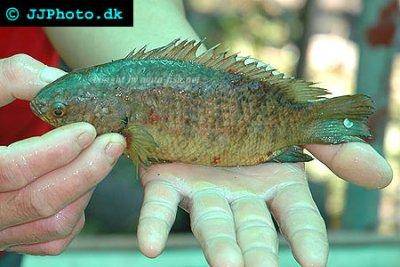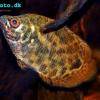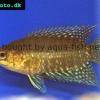Climbing perch - Anabas testudineus
Scientific name: Anabas testudineus
Common name: Climbing perch
Family: Anabantidae
Usual size in fish tanks: 17 - 25 cm (6.69 - 9.84 inch)
014
Recommended pH range: 7 - 8
Recommended water hardness: 5 - 19°N (89.29 - 339.29ppm)
0°C 32°F30°C 86°F
Recommended temperature range: 22 - 27 °C (71.6 - 80.6°F)
The way how these fish reproduce: Spawning
Where the species comes from: South Asia
Temperament to its own species: peaceful
Temperament toward other fish species: peaceful
Usual place in the tank: Bottom levels
Origin
Climbing perch are native to Southeast Asia, with their range extending across India, Sri Lanka, and Southern China.
Lifespan
Climbing perch typically live between 5 and 8 years.
Short Description
In their natural habitat, Climbing perch are found in small streams and occasionally in brackish waters. However, for optimal health, it is best to keep them in freshwater. Their common name comes from myths suggesting they can climb trees, but in reality, they do not possess this ability.
Climbing perch are relatively low-maintenance but require some specific conditions in their aquarium. It's crucial to leave some air space between the water surface and the top of the tank, as they need to breathe atmospheric air. Ensure this space is kept humid to protect their primitive lungs. While they do well under dim lighting, they can also adapt to brighter setups if aquatic plants are included in the tank.
Anabas testudineus are skilled jumpers, so a tightly fitting lid is essential for large tanks. High-quality filtration is necessary due to their high waste production, and regular water changes are required. These fish can be aggressive, though behavior may vary between individuals. They can be kept in groups if the tank is spacious enough, but avoid housing them with smaller fish, as they may see them as food. Instead, pair them with similarly sized and tempered species.
Food and Feeding
Climbing perch require a varied diet to stay healthy. Provide high-quality flakes and pellets, and include vegetables like lettuce, spinach, and peas. Supplement their diet with meaty foods such as chopped earthworms and bloodworms. Once they are accustomed to their new environment, they are generally not picky about food. However, a balanced diet that includes both meaty and vegetable items will enhance their color and support their long-term health.
Sexing
There are no noticeable differences between male and female climbing perch.
Breeding
To breed climbing perch, use a tank with plenty of plants. Spawning usually occurs in the evening, and the eggs are deposited among the plants. The eggs will hatch within 24 to 36 hours. The fry are left to fend for themselves as climbing perch do not care for their young. Although the parents do not eat the fry, it’s best to raise the fry in a separate tank to ensure optimal water quality. Feed the fry newly hatched brine shrimp, and provide a suitable diet for their size to support their growth.
Pictures
Bought by aqua-fish.net from jjphoto.dk.



 Spotted
Spotted  Congo
Congo